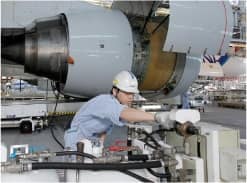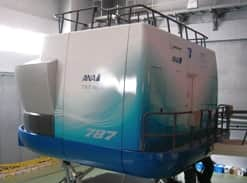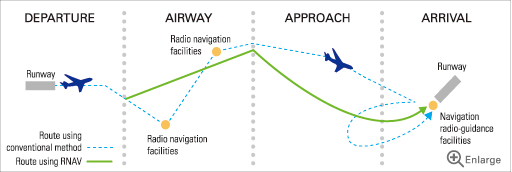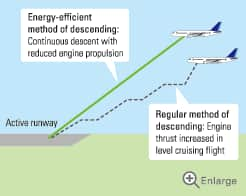Global Warming Countermeasures
ANA Group Ecology Plan 20082011
Reducing CO2 Emissions from Aircraft
Unique Environmental Initiatives and the ANA Group Ecology Plan
As a world-leading eco-friendly airline, ANA conducts unique environmental initiatives with all employees actively pursuing objectives of the ANA Group Ecology Plan (20082011).
Since 2008, when the ANA Group was the airline and transport industrys first certified Eco-First company, we not only have set strict goals for reducing CO2 emissions but also have pursued recent activitieslike deploying new-generation, eco-friendly aircraft, carbon offsets, and e-flightthat demonstrate a core focus on environmental preservation and contributions to society. The following is a summary of results up to FY2009.
Reducing CO2 Emissions from Aircraft Fuel
This graph shows the targets of the ANA Group Ecology Plan 2008-2011 for total CO2 emissions on domestic routes and CO2 emissions per revenue passenger for domestic and overseas routes combined. With the drop in the load factor following the global economic downturn, CO2 emissions per revenue passenger worsened at one stage, but they are now steadily improving due to such factors as various fuel reduction measures and adjustments to aircraft investment.
In the fiscal year ended March 2010, CO2 emissions per revenue ton kilometer (RTK) were 1.16 kilograms, a decrease of about 5.5 percent from the previous fiscal year. Total emissions from domestic flights were 4.26 million tons, down from 4.55 million tons in the previous fiscal year. Combined with international flights, total emissions came to 7.59 million tons, significantly less than the 8.06 million tons of the previous fiscal year. ANA will continue its efforts to reduce CO2 emissions and work together with associated organizations to actively engage in research toward development of alternative fuels in the future.
Environmental Impact in Our Operations
Reducing fuel consumed by aircraft is directly connected to reducing environmental impact. We have long been actively engaged in a variety of fuel reduction measures in flight and ground operations. ANA has improved flight efficiency since the previous fiscal year through the formation of Team ASPIRE*1, a body supervised by the Civil Aviation Bureau of the Ministry of Land, Infrastructure and Transport. The following are some of the initiatives the ANA Group is undertaking.
*1 |
ASPIRE: The Asia and Pacific Initiative to Reduce Emissions, the name given to activities aimed at reducing fuel consumption and gas emissions through joint efforts by air traffic control agencies and airlines to conduct efficient operations. |
When Preparing for Departure

Shared use of GPU power
Proactive Use of
Ground Power Units
Parked aircraft normally consume electric power by running APUs*2 for such uses as air conditioning and lighting inside the aircraft. However, since 1990 the ANA Group has actively used ground power units (GPUs), which are much more energy efficient, instead of APUs. As a result, in the fiscal year ended March 2010, we reduced CO2 emissions by 97,000 tons and fuel consumption by 39,600 kiloliters compared to not using GPUs. These savings are equivalent to the emissions of a Boeing 777-200 making approximately 2,600 round trips between Tokyo and Osaka.
*2 |
APU: Auxiliary Power Unit, a small on-board gas turbine that provides electricity for the aircraft and compressed air for starting the engine and air conditioning. APUs are less energy efficient than GPUs as they burn jet fuel. |
When Cruising
Operation of RNAV (Area Navigation)
RNAV navigation is a procedure that navigates aircraft and assures the scheduled flight path by radio-navigation facilities as well as by satellite and on-board equipment. Not only does RNAV achieve faster and shorter fights while reducing fuel consumption and CO2 emissions, it also reduces noise around airports.
RNAV Navigation vs. Conventional Routing
When Descending
Promoting Energy-Efficient
Descent Method
When an aircraft descends continuously from the start to the end of its descent without leveling off, it saves fuel, cuts CO2emissions and reduces noise. Official Continuous Descent Operation (CDO*4) at Kansai International Airport began in June 2010. The ANA Group will cooperate with associated organizations to implement the system at other airports.
| *4 | CDO: Continuous Descent Operation, a collective term for operations including CDA (continuous descent approach), TA (tailored arrival), OPM (optimum profile descent), etc. |
When Arriving at Airports
Reducing the Power of Thrust Reversers for Landing
Normally, in order to reduce an aircrafts landing length, thrust reversers are employed, engine thrust is increased (which emits CO2) and the exhaust is sent forward. By landing with the engines in idle to the extent possible when it is safe to do so, based on an assessment of the landing length and other factors, CO2 emissions are reduced and noise pollution is mitigated, which makes this method of landing more environmentally friendly. In the fiscal year ended March 2010, this reduced CO2 emissions by 13,700 tons and fuel consumption by 5,580 kiloliters.
Initiatives in Areas Other Than Flight Operations

Engine washing
Maintaining Peak Engine
Performance by Washing Engine
Compressor Sections
During engine use, minute lumps that reduce fuel economy collect on the compressor section. Since 2003, the ANA Group has been using original engine washing machines to wash dust off engine compressor sections to maintain peak engine performance and improve fuel usage. As a result of maintaining peak performance after washing, we reduced CO2 emissions by 43,000 tons and fuel consumption by 17,500 kiloliters in the year ended March 2010. These savings are equivalent to the emissions of a Boeing 777-200 making approximately 1,150 round trips between Tokyo and Osaka.

Simulator
Saving Fuel Through Use of
Simulators
The ANA Group mainly uses flight simulators to train and evaluate flight crews, thereby reducing fuel consumption (CO2 emissions) and noise, and helping us make the most of limited air space.
In FY 2009, if total simulator hours were actual flight time, they would have emitted 650,000 tons of CO2 and required 266,000 kiloliters of fuel in FY 2009, saving about 18,000 round trips between Tokyo and Osaka (Itami) on a Boeing 777-200.
Introduction of Next-Generation Aircraft
Boeing 787
ANA is the launch customer for the Boeing 787. We have ordered 55 Boeing 787 aircraft ahead of the competition and have been involved from its design and development stages. Our first Boeing 787 is scheduled to begin service in 2011 as the successor to the Boeing 767, our mainstay fleet aircraft, with an eye on the expansion of Haneda Airport.
Boeing 787
Next-Generation Mitsubishi Regional Jet (MRJ)
ANA has decided to introduce the next-generation Mitsubishi Regional Jet (MRJ), to be developed by Mitsubishi Aircraft Corporation. ANA has placed a firm order for 15 MRJ aircraft and 10 options as the launch customer.
The MRJ will be the first regional jet to use composite material for the wings and a vertical stabilizer. The new engine driven by the latest technology will significantly reduce the environmental impact of the aircraft. State-of-the-art aerodynamics should bring about an approximate 40% savings in fuel compared with current aircraft in the same class.
Next-Generation Mitsubishi Regional Jet (MRJ)





